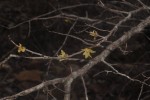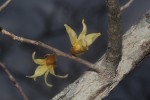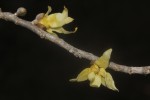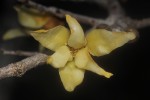Hexalobus monopetalus [Agg]
Selected images: Click on each image to see a larger version and details of the record View all images (10)
Detailed records: Display species records QDS maps by: Google Maps Point records by Google Maps
Species details: Click on each item to see an explanation of that item (Note: opens a new window)
| Synonyms: |
Hexalobus glabrescens Hutch. & Dalz. ex Burtt Davy Hexalobus senegalensis A. DC. Uvaria huillensis Engl. & Diels Uvaria monopetala A. Rich. |
| Common names: | Baboons' breakfast (English) Shakama plum (English) |
| Frequency: | |
| Status: | Native |
| Description: |
Deciduous shrub or small tree. Leaves alternate, held in one plane, oblong-elliptic to obovate with variously covered in short reddish hairs on the undersurface, sometimes only along the midrib. Flowers solitary in the leaf axils with long slender, twisted petals, usually opening only when the tree is leafless. Fruit in 1-3 cylindric segments, sparsely covered in short hairs, red when ripe, edible. |
| Type location: |
Zambia, Mwinilunga District |
| Notes: | Two varieties, var. monopetalus and var. obovatus, are known in Mozambique. They differ mainly in leaf-shape and more or less prominent venation but intermediates are known where both varieties are found close together. |
| Derivation of specific name: | |
| Habitat: | In hot dry woodland and scrub, on rocky hillsides and in riverine thickets. |
| Altitude range: (metres) | |
| Flowering time: | Oct - Nov |
| Worldwide distribution: | Widespread in tropical Africa and Southern Africa. |
| FZ divisions: | N,T,MS,GI |
| Growth form(s): | Tree, shrub over 2 m. |
| Endemic status: | |
| Red data list status: | |
| Insects associated with this species: | Graphium antheus (Food plant) Graphium morania (Larval foodplant) |
| Spot characters: | Display spot characters for this species |
| Images last updated: | Saturday 27 April 2019 |
| Literature: |
Burrows, J.E., Burrows, S.M., Lötter, M.C. & Schmidt, E. (2018). Trees and Shrubs Mozambique Publishing Print Matters (Pty), Cape Town. Page 121. (Includes a picture). Coates Palgrave, K. (revised and updated by Meg Coates Palgrave) (2002). Trees of Southern Africa 3rd edition. Struik, South Africa Page 207. Da Silva, M.C., Izidine, S. & Amude, A.B. (2004). A preliminary checklist of the vascular plants of Mozambique. Southern African Botanical Diversity Network Report No. 30 Sabonet, Pretoria Page 23. Drummond, R.B. (1981). Common Trees of the Central Watershed Woodlands of Zimbabwe. Natural Resources Board, Harare. Pages 32 - 33. (Includes a picture). Kamumvuri, G. (ed.) (2004). Plants of Zimbabwe Report No. 1 National Herbarium and Botanic Garden, Zimbabwe Page 20. Mapaura, A. & Timberlake, J. (eds) (2004). A checklist of Zimbabwean vascular plants Southern African Botanical Diversity Network Report No. 33 Sabonet, Pretoria and Harare Page 17. Meerts, P. & Hasson, M. (2016). Arbres et arbustes du Haut-Katanga Jardin Botanique Meise, Belgique Page 165. (Includes a picture). Phiri, P.S.M. (2005). A Checklist of Zambian Vascular Plants Southern African Botanical Diversity Network Report No. 32 Page 22. as var. obovatus Schmidt, E., Lötter, M. & McCleland, W. (2002). Trees and shrubs of Mpumalanga and Kruger National Park Jacana, Johannesburg, South Africa Pages 108 - 109. as var. monopetalus (Includes a picture). Smith, P. & Allen, Q. (2004). Field Guide to the Trees and Shrubs of the Miombo Woodlands Royal Botanic Gardens, Kew ISBN 1 84246 073 0 Pages 56 - 57. (Includes a picture). Van Wyk, B. & Van Wyk, P. (1997). Field Guide to Trees of Southern Africa. Struik, South Africa Pages 158 - 159. (Includes a picture). Van Wyk, B. & Van Wyk, P. (2013). Field Guide to Trees of Southern Africa (Second edition) Struik, South Africa Pages 182 - 183. (Includes a picture). |
Other sources of information about Hexalobus monopetalus:
Our websites:
Flora of Botswana: Hexalobus monopetalusFlora of the DRC: Hexalobus monopetalus
Flora of Malawi: Hexalobus monopetalus
Flora of Zambia: Hexalobus monopetalus
Flora of Zimbabwe: Hexalobus monopetalus
External websites:
African Plants: A Photo Guide (Senckenberg): Hexalobus monopetalusAfrican Plant Database: Hexalobus monopetalus
BHL (Biodiversity Heritage Library): Hexalobus monopetalus
EOL (Encyclopedia of Life): Hexalobus monopetalus
GBIF (Global Biodiversity Information Facility): Hexalobus monopetalus
Google: Web - Images - Scholar
iNaturalist: Hexalobus monopetalus
IPNI (International Plant Names Index): Hexalobus monopetalus
JSTOR Plant Science: Hexalobus monopetalus
Mansfeld World Database of Agricultural and Horticultural Crops: Hexalobus monopetalus
Plants of the World Online: Hexalobus monopetalus
Tropicos: Hexalobus monopetalus
Wikipedia: Hexalobus monopetalus





